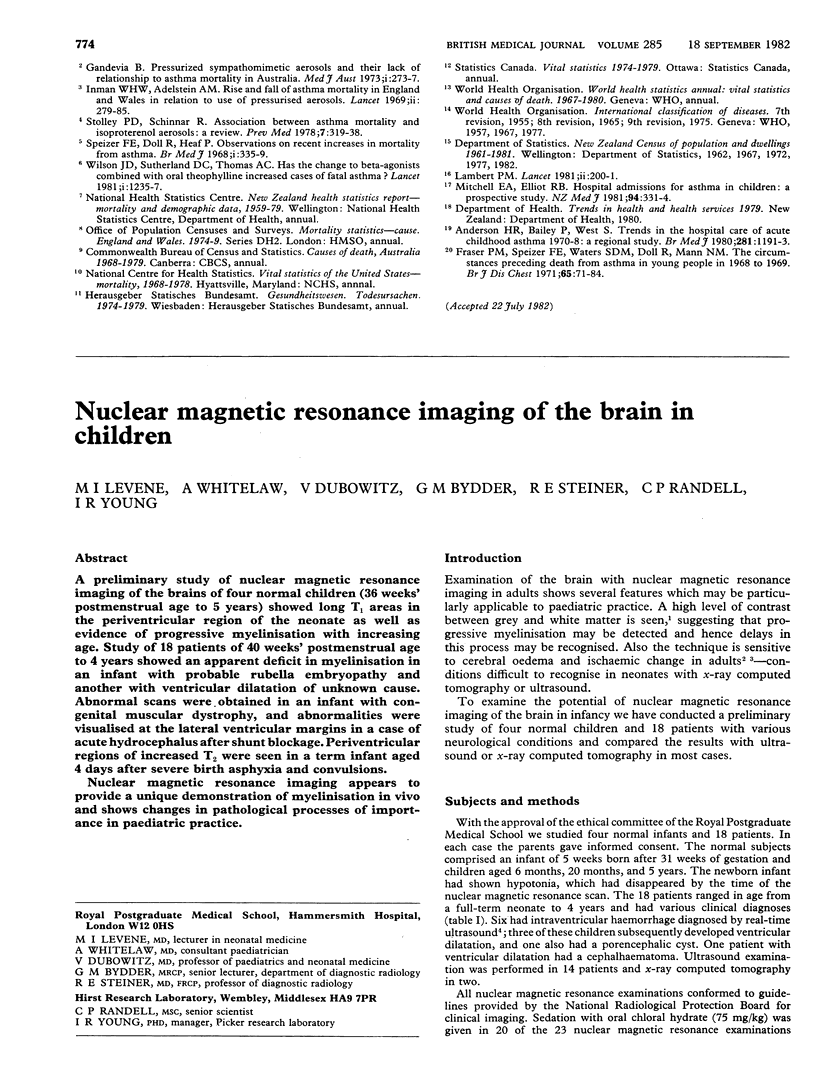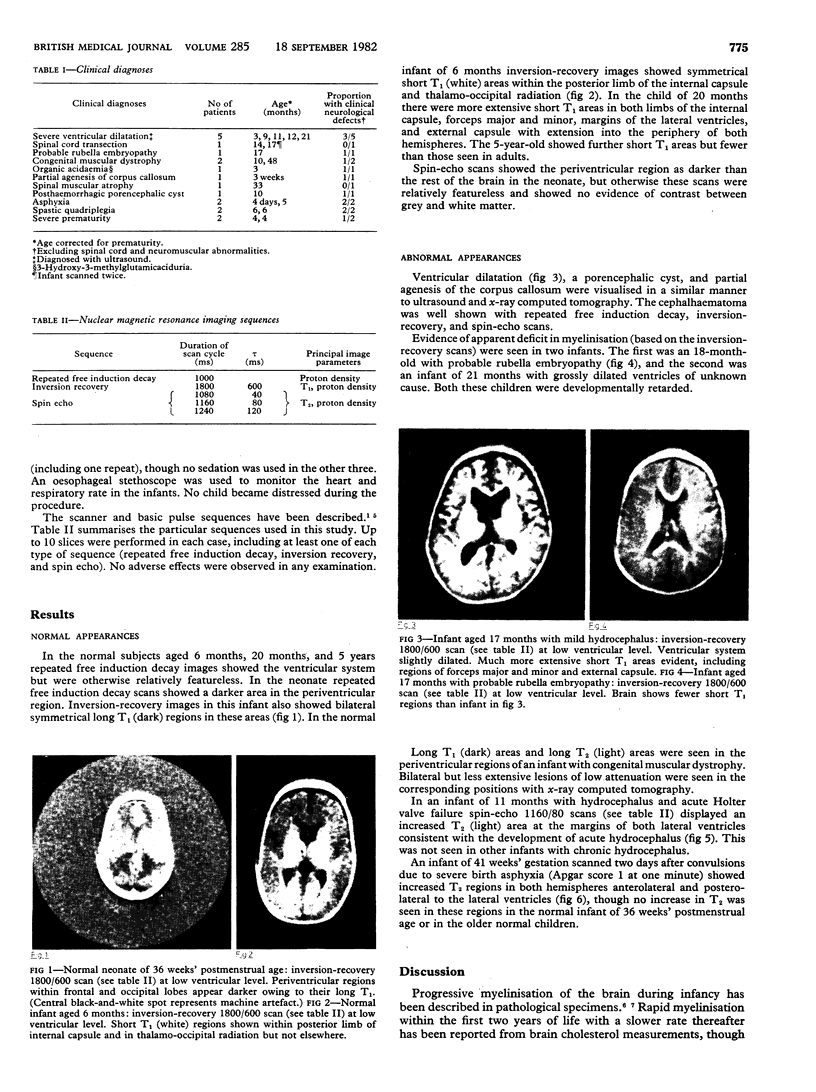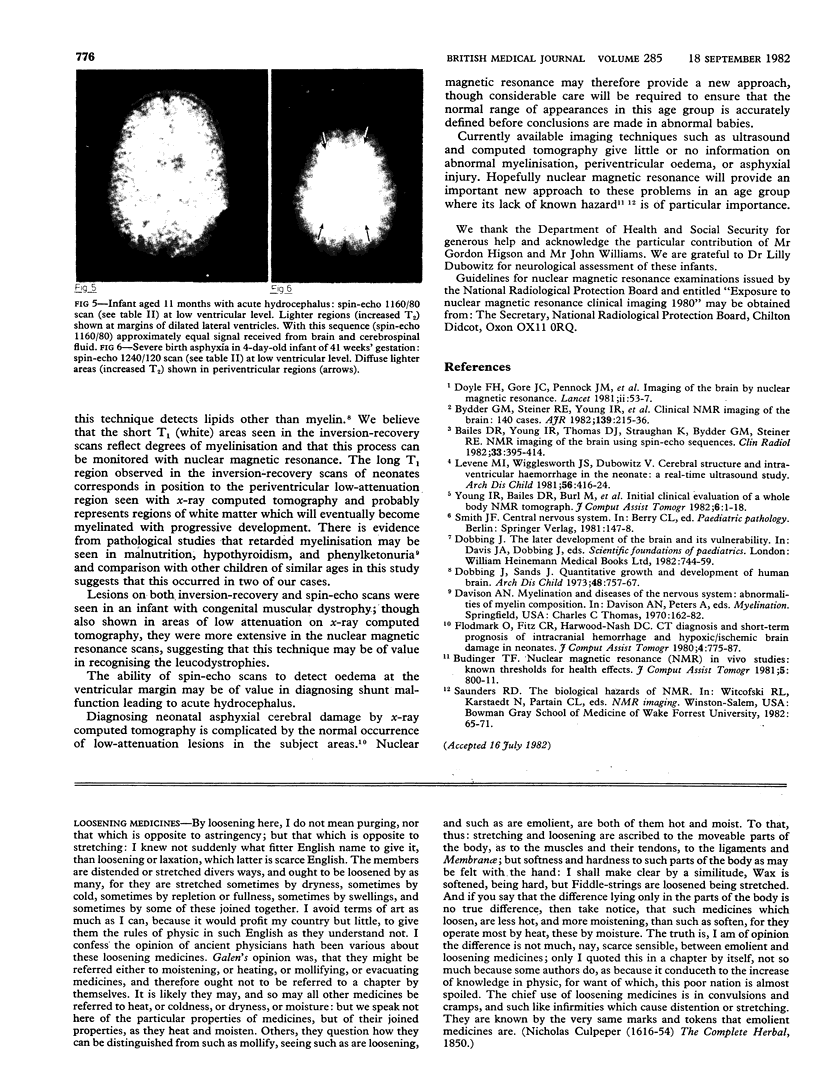Abstract
A preliminary study of nuclear magnetic resonance imaging of the brains of four normal children (36 weeks' postmenstrual age to 5 years) showed long T1 areas in the periventricular region of the neonate as well as evidence of progressive myelinisation with increasing age. Study of 18 patients of 40 weeks' postmenstrual age to 4 years showed an apparent deficit in myelinisation in an infant with probable rubella embryopathy and another with ventricular dilatation of unknown cause. Abnormal scans were obtained in an infant with congenital muscular dystrophy, and abnormalities were visualised at the lateral ventricular margins in a case of acute hydrocephalus after shunt blockage. Periventricular regions of increased T2 were seen in a term infant aged 4 days after severe birth asphyxia and convulsions.
Nuclear magnetic resonance imaging appears to provide a unique demonstration of myelinisation in vivo and shows changes in pathological processes of importance in paediatric practice.
Full text
PDF


Images in this article
Selected References
These references are in PubMed. This may not be the complete list of references from this article.
- Bailes D. R., Young I. R., Thomas D. J., Straughan K., Bydder G. M., Steiner R. E. NMR imaging of the brain using spin-echo sequences. Clin Radiol. 1982 Jul;33(4):395–414. doi: 10.1016/s0009-9260(82)80307-3. [DOI] [PubMed] [Google Scholar]
- Budinger T. F. Nuclear magnetic resonance (NMR) in vivo studies: known thresholds for health effects. J Comput Assist Tomogr. 1981 Dec;5(6):800–811. doi: 10.1097/00004728-198112000-00003. [DOI] [PubMed] [Google Scholar]
- Bydder G. M., Steiner R. E., Young I. R., Hall A. S., Thomas D. J., Marshall J., Pallis C. A., Legg N. J. Clinical NMR imaging of the brain: 140 cases. AJR Am J Roentgenol. 1982 Aug;139(2):215–236. doi: 10.2214/ajr.139.2.215. [DOI] [PubMed] [Google Scholar]
- Dobbing J., Sands J. Quantitative growth and development of human brain. Arch Dis Child. 1973 Oct;48(10):757–767. doi: 10.1136/adc.48.10.757. [DOI] [PMC free article] [PubMed] [Google Scholar]
- Doyle F. H., Gore J. C., Pennock J. M., Bydder G. M., Orr J. S., Steiner R. E., Young I. R., Burl M., Clow H., Gilderdale D. J. Imaging of the brain by nuclear magnetic resonance. Lancet. 1981 Jul 11;2(8237):53–57. doi: 10.1016/s0140-6736(81)90408-6. [DOI] [PubMed] [Google Scholar]
- Flodmark O., Fitz C. R., Harwood-Nash D. C. CT diagnosis and short-term prognosis of intracranial hemorrhage and hypoxic/ischemic brain damage in neonates. J Comput Assist Tomogr. 1980 Dec;4(6):775–787. doi: 10.1097/00004728-198012000-00008. [DOI] [PubMed] [Google Scholar]
- Levene M. I., Wigglesworth J. S., Dubowitz V. Cerebral structure and intraventricular haemorrhage in the neonate: a real-time ultrasound study. Arch Dis Child. 1981 Jun;56(6):416–424. doi: 10.1136/adc.56.6.416. [DOI] [PMC free article] [PubMed] [Google Scholar]
- Young I. R., Bailes D. R., Burl M., Collins A. G., Smith D. T., McDonnell M. J., Orr J. S., Banks L. M., Bydder G. M., Greenspan R. H. Initial clinical evaluation of a whole body nuclear magnetic resonance (NMR) tomograph. J Comput Assist Tomogr. 1982 Feb;6(1):1–18. doi: 10.1097/00004728-198202000-00001. [DOI] [PubMed] [Google Scholar]





